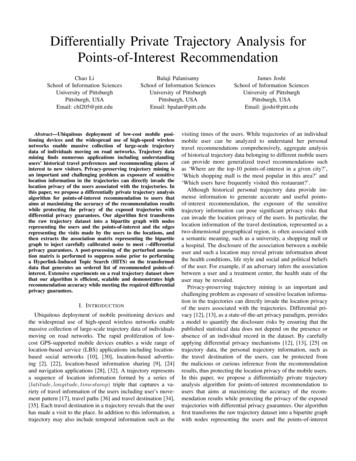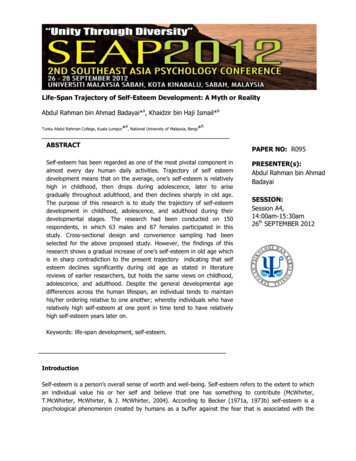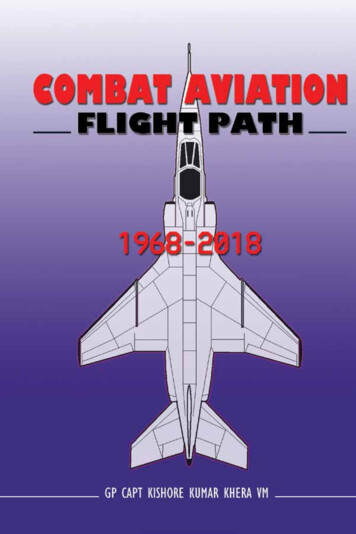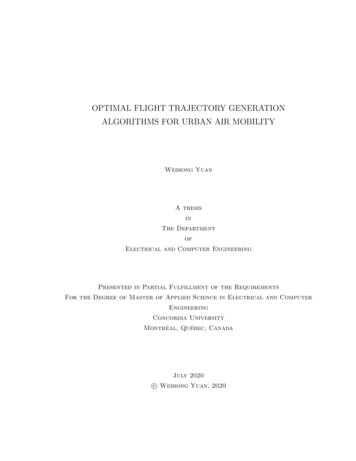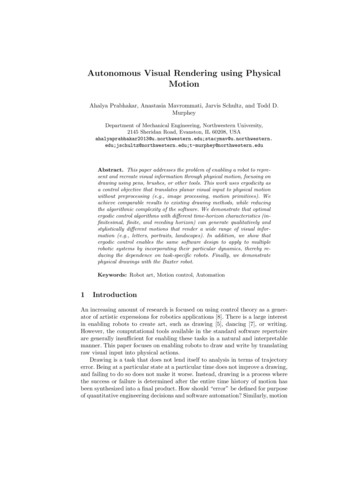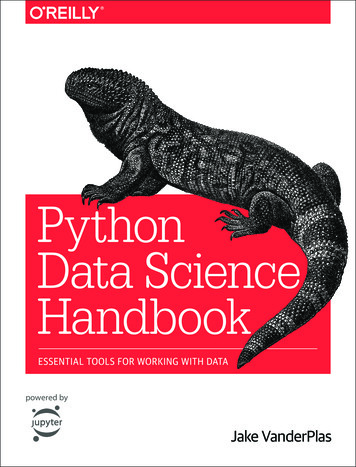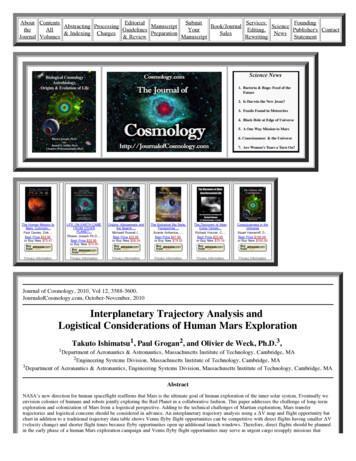
Transcription
About g linesYourEditing,Publisher's Contact& Indexing ChargesPreparationSalesNewsJournal Volumes& ReviewManuscriptRewritingStatementThe Human Mission toMars. Colonizin.Paul Davies, Dirk .Best Price 54.95or Buy New 75.47LIFE ON EARTH CAMEFROM OTHERPLANET.Rhawn Joseph Ph.D,.Best Price 32.95or Buy New 70.00Origins, Abiogenesis andthe Search .Michaell Russell (.Best Price 33.95or Buy New 56.34The Biological Big Bang.Panspermia .Svante Arrhenius, .Best Price 47.95or Buy New 79.52The Discovery of AlienExtra-Terrest.Richard Hoover, C.Best Price 33.95or Buy New 70.16Consciousness in theUniverseStuart Hameroff, D.Best Price 100.00or Buy New 100.00Privacy InformationPrivacy InformationPrivacy InformationPrivacy InformationPrivacy InformationPrivacy InformationJournal of Cosmology, 2010, Vol 12, 3588-3600.JournalofCosmology.com, October-November, 2010Interplanetary Trajectory Analysis andLogistical Considerations of Human Mars ExplorationTakuto Ishimatsu1, Paul Grogan2, and Olivier de Weck, Ph.D.3,1 Departmentof Aeronautics & Astronautics, Massachusetts Institute of Technology, Cambridge, MASystems Division, Massachusetts Institute of Technology, Cambridge, MA3 Department of Aeronautics & Astronautics, Engineering Systems Division, Massachusetts Institute of Technology, Cambridge, MA2 EngineeringAbstractNASA’s new direction for human spaceflight reaffirms that Mars is the ultimate goal of human exploration of the inner solar system. Eventually weenvision colonies of humans and robots jointly exploring the Red Planet in a collaborative fashion. This paper addresses the challenge of long-termexploration and colonization of Mars from a logistical perspective. Adding to the technical challenges of Martian exploration, Mars transfertrajectories and logistical concerns should be considered in advance. An interplanetary trajectory analysis using a ΔV map and flight opportunity batchart in addition to a traditional trajectory data table shows Venus flyby flight opportunities can be competitive with direct flights having smaller ΔV(velocity change) and shorter flight times because flyby opportunities open up additional launch windows. Therefore, direct flights should be plannedin the early phase of a human Mars exploration campaign and Venus flyby flight opportunities may serve as urgent cargo resupply missions that
cannot wait until next direct flight opportunities. Cargo flights for pre-positioning should minimize ΔV while crewed flights should reduce flight timeat the cost of higher ΔV to minimize crew exposure to reduced gravity and space radiation during in-space transports. SpaceNet analysis from alogistics perspective reveals that the Mars exploration architecture as described by NASA’s Mars DRA 5.0 is propulsively feasible but logisticallyinfeasible without modifications to increase supply capacity during crewed transport and exploration periods. The most constrained transportation legsinclude the surface habitat (SHAB) and Mars descent/ascent vehicle (MDAV) descents to the Martian surface and the crewed MTV transit to Mars.Key Words: Human Mars Exploration, Space Logistics, Launch Window, Mars DRA 5.0, Pre-Positioning, ISRU.1. IntroductionThe Red Planet has been a long-held goal of human spaceflight ever since NASA’s two Viking probes landed there in 1976.Announced in 2004, the Vision for Space Exploration was to seek to implement a sustained and affordable human and roboticprogram to extend human presence across the solar system, starting with a human return to the Moon in preparation for humanexploration of one of the ultimate destinations, Mars (Bush 2004; NASA 2004). This vision encouraged engineers to define andrefine the top-level requirements and configurations for crew and cargo launch systems and to develop an exploration architectureconcept to support sustained human and robotic Mars exploration programs (NASA 2005). The final report of the Review of U.S.Human Spaceflight Plans Committee, released in October 2009, also states that "a human landing followed by an extended humanpresence on Mars stands prominently above all other opportunities for exploration. Mars is unquestionably the most scientificallyinteresting destination in the inner solar system, with a planetary history much like Earth’s" (Review of U.S. Human SpaceflightPlans Committee 2009). Although the Constellation Program is facing cancellation, NASA’s new plan for space explorationreaffirms that Mars is the ultimate goal of human exploration of the inner solar system (Bolden 2010, Obama 2010). In response tothis background, it can be expected to see an increasing number of robotic explorations of Mars over the next several decades,eventually followed by human missions. Eventually we envision colonies of humans and robots jointly exploring the Red Planet in acollaborative fashion. This paper addresses the challenge of long-term exploration and colonization of Mars from a logisticalperspective.NASA has undertaken substantial effort to develop a design reference architecture (DRA) for conceptual missions to Mars. DRArepresents the current "best" strategy for human missions and architectures and should be constantly updated as we learn. It alsoserves as a benchmark against which alternative architectures can be measured. The most recent publication is Mars DRA 5.0 (Drake2009, 2010). This design reference describes the spacecraft and missions which could be used for the first three excursions to thesurface of Mars. The Mars exploration architecture is heavily based on lunar concepts from the Constellation Program, including theAres V heavy lift launch vehicle, but also includes advanced technology concepts such as nuclear thermal rockets (NTR) forinterplanetary propulsion, zero-loss cryogenic coolers for propellant transportation, aerocapture as the Mars arrival capture method,in-situ resource utilization (ISRU) for Mars ascent propellant production, and nuclear fission reactors for surface power.
Figure 1: Earth-Mars logistical network with ΔV [km/s] shown along each transportation link.Adding to the technical challenges of Martian exploration, logistical concerns should be considered far in advance. Far away fromhome, depending on complex equipment, and with limited capability to manufacture the basic resources to sustain life, astronauts areconstantly at risk of logistical lapses. A well-planned logistics strategy is essential to balance risks, ensure robustness, and achievemaximum exploration capability. Although a vast body of research exists for terrestrial supply chain logistics in business andmilitary applications, space exploration introduces several fundamental differences. First, unlike transports on Earth, space resupplymissions are possible only at discrete intervals corresponding to favorable positions of planetary bodies and accommodating leadtimes required for spacecraft manufacturing, assembly, and ground operations. Second, transports in space can last significantlylonger (weeks and months) compared to terrestrial transport options which tend to unfold in hours and days with the exception ofocean freight. Finally, the fraction of usable cargo in space vehicles is an order of magnitude smaller than that of terrestrialtransports. While a semi-trailer gross weight may be nearly 50% cargo and a passenger aircraft about 10%, usable cargo massfractions for launch vehicles to low-5 Earth orbit including to the International Space Station range between 0.5% to 1.5% and theApollo lunar landings contribute a mere 0.05%.The challenges of space logistics – infrequent launch windows, long transport durations, and minimal cargo capacity – emphasize theimportance of Mars transfer trajectories design and analysis. Planning future missions requires advance trajectory data such asdeparture and arrival dates (times of flight), C3 (energy required for departure), and ΔV for departure, arrival, and flyby maneuvers.The past studies of interplanetary trajectories have been mainly focused on showing trajectory data in the form of tables that tabulateonly one typical choice of launch and arrival dates for each launch window, which is selected based on a minimum C3 over eachlaunch window (Matousek and Sergeyevsky 1998). Considering interplanetary missions from the perspective of not individualmissions but a long-term spaceflight campaign, however, future mission designers should have more exhaustive in-hand trajectorydata by which they can perform a trade-off analysis between C3 and time of flight (i.e., duration) within each launch window or evenbetween neighboring launch windows.In summary, to safely explore distant locations in space logistics must respond to a wide range of unexpected events far enough inadvance to accommodate launch window opportunities and the long-duration transports while working with severely limited masscapacities. These opposing constraints may require advanced strategies such as completely closed-loop environmental control andlife support systems, ISRU and manufacturing or repair capabilities, highly efficient packing and container design, significant partcommonality between systems, and orbital supply depots. Additionally it is desirable that one mission build on the next and soconcepts like pre-positioning and reuse becoming major enablers.2. Earth-Mars Mission Launch Catalog
2.1. Interplanetary Trajectories to and from Mars There are two main types of interplanetary trajectories from Earth to Mars:Earth-Mars direct trajectories (Fig. 2) and Earth-Venus-Mars flyby trajectories (Fig. 3). One of the important characteristicsrepresenting a trajectory is the energy required for departure, referred to as C3. A lower C3 is desired since it indicates a smallervelocity change, ΔV, for transfer injection, consuming less fuel. A lower ΔV at arrival also results in less fuel for braking orimposes a less stringent requirement for insulating against heating generated through aerocapture.Figures 2 & 3: (left) Earth-Mars direct trajectory. (right) Earth-Venus-Mars flyby trajectory.Against the aforementioned background of interplanetary trajectory data, Ishimatsu et al. developed a tool capable of creating notonly a trajectory data table but also an exhaustive ΔV map for both direct and flyby trajectories in a single chart (Ishimatsu 2008;Ishimatsu et al. 2009, 2010). The contours of ΔV for a range of departure dates (x-axis) and times of flight (y-axis) serve as a "visualcalendar" of launch windows useful for the creation of a long-term transportation schedule for mission planning purposes.2.2. Mission Launch Windows Figure 4 shows an exhaustive ΔV map (upper) and a "flight opportunity bat chart" (lower) for the2030-2040 time frame during which manned missions to Mars seem most likely to happen while Table 1 is a traditional tabular formof interplanetary trajectory data. As the criteria for mission feasibility to filter this ΔV map, the following four constraints weredefined: 1) a departure C3 must be less than 30 [km2/s2] due to launch feasibility, 2) an arrival C3 must be less than 40 [km2/s 2] forMars arrival and 45 [km2/s 2] for Earth arrival, respectively, due to aerocapture tolerance, 3) a minimum passing altitude at Venusflyby must be greater than 100 km above the surface, and 4) a ΔV for powered flyby maneuver should be less than 0.3 [km/s]. Acircular parking orbit with an altitude of 300 km was assumed in the conversion from C3 to ΔV. Note that ΔVtot is the sum of adeparture ΔV and a powered flyby maneuver 7 ΔV, if any (an arrival ΔV is ignored assuming aerocapture). Filtered by the abovefour constraints, the "craters" in the figure represent "mission feasible" regions, ΔVtotranging from 3.6 to 4.8 [km/s].
Figure 4: 2030-2040 Earth-Mars ΔVtot [km/s] map (upper) and flight opportunity bat chart (lower).Table 1: 2030-2040 Earth-Mars trajectory data.A mission scenario is often represented by a "bat chart." In a bat chart, a mission scenario is indicated by edges in a graph where thex-axis represents dates and the y-axis represents nodes. However, flight opportunities of interplanetary missions are highly timedependent in terms of ΔV so that possible edges in a bat chart are limited to some extent. Thus, a bat chart with all possible edgesdrawn is defined as a "flight opportunity bat chart," each bunch of edges corresponding to a launch window. In Fig. 4, Earth-Marsdirect flight and Earth-Venus-Mars flyby flight opportunities are represented by blue and red lines, respectively. This chart, alongwith a ΔV map, can be used to see the flexibility of the transportation schedule and to perform a trade-off analysis betweendeparture and arrival dates, time of flight, and ΔV required for each maneuver on a mission-by-mission basis.Additionally, the "competitiveness" of each launch opportunity is defined by the following criteria and shown in the rightmostcolumn of Table 1.If two neighbor opportunities have an overlapping departure date (an overlapping arrival date), and one has an earlier arrivaldate (a later departure date) than the other, the other is regarded as "dominated" since a shorter time of flight would be desirablefrom the perspective of exposure to both reduced gravity and space radiation.
.If an opportunity does not have neighbors with overlapping departure or arrival dates, the opportunity is non-dominated andthus regarded as "competitive" since it would add a new launch window even if it requires a relatively high ΔV.Between 2030 and 2040 three out of four flyby windows are competitive because they open up new additional opportunities thatcannot be replaced by direct flight opportunities. Having more launch windows available gives us flexibility of mission planning.However, those flyby windows tend to have a relatively high ΔVtot and a long time of flight.Completing a round-trip mission, Mars-Earth return trajectories are shown in Fig. 5 and Table 2. Since Mars gravity is less thanEarth’s, trans-Earth injection (TEI) requires a relatively small energy, ΔVtot ranging from 2 to 4 [km/s]. As no good timing of theMars-Venus-Earth relative configurations exists under the above four constraints, there are no flyby opportunities available duringthis time period.Figure 5: 2030-2040 Mars-Earth ΔVtot [km/s] map (upper) and flight opportunity bat chart (lower).Table 2: 2030-2040 Mars-Earth return trajectory data.It can be observed from the above results that flyby flights can be competitive because they open up additional launch windows inbetween but in general, direct flights are preferable to flyby flights in terms of both ΔV and time of flight. Therefore, direct flightsshould be taken in the early phase of human Mars exploration campaign while flyby flights may serve as urgent cargo resupplymissions that cannot wait until next direct flight opportunities. Flyby flights could be more important if a permanent presence isestablished on Mars.Cargo flights for pre-positioning should minimize ΔV since a long transport duration does not have much impact. For crewed
flights, on the other hand, a shorter time of flight would be desirable even at the cost of somewhat higher ΔV from the perspective ofcrew exposure to both reduced gravity and space radiation during in-space transports.3. Mars Campaign Analysis3.1. Space Exploration Strategic Analysis Space exploration campaigns are characterized by highly-coupled missions and elementsfunctioning within a spatially-distributed network over a long duration. An integrative approach to campaign analysis is beneficial toaccommodate the many levels of system decomposition and mixed levels of fidelity required to analyze futuristic exploration. Aspace exploration campaign may be broken down into small components for which detailed models can be created and the resultantproduct aggregated back to the system level. The process of system decomposition and integration to uncover lifecycle systemproperties of space exploration has been referred to as strategic analysis (Cirillo et al. 2008).In coordination with NASA’s Constellation Program lunar architectural studies in 2004-2005, MIT founded its Space LogisticsProject to build a research base supporting interplanetary supply chain management and logistical analysis necessary for extendedexploration campaigns. The project initially studied several terrestrial analogs to space exploration, including operations in remoteterrestrial environments such as the Arctic and Antarctic, commercial supply chains, and military logistics operations, culminating inthe development of a space logistics framework (de Weck and Simchi-Levi 2006, Shull et al. 2006, Taylor et al. 2007).SpaceNet implements the established space logistics framework within a discrete event simulation environment to support campaignanalyses and trade studies (de Weck et al. 2007, Lee et al. 2008, Armar and de Weck 2009). From a logistics perspective, SpaceNetevaluates the movement of resources in attempt to satisfy demands during an exploration campaign. Demands originate from crewmembers requiring food, water, gases, and hygiene items, infrastructure elements requiring spares or replacement parts, and vehiclesrequiring propellant required to complete transports. For feasible campaigns (those in which all demands can be satisfied), sensitivityand trade studies evaluate system responses to changes and inform design decisions.Figure 6: SpaceNet campaign modeling and analysis sequence (Grogan 2010).Modeling and analyzing space exploration within SpaceNet is comprised of four steps, as illustrated in Fig. 6. First, a time-expandednetwork model is constructed which encompasses all of the surface and orbital locations (nodes) to be reached and the availablepaths between nodes (edges) over time. Physics-based network constraints including selected trajectories’ ΔV requirements areincluded in the network model inputs. Second, a baseline mission sequence is defined. Each mission model is comprised of eventssuch as element initialization, transportation segments, and exploration processes which drive a discrete event simulation. Propulsivefeasibility, i.e., verifying sufficient fuel is available to complete all propulsive transportation burns, is established during the missiondefinition phase. Third, a demands analysis is performed to inspect the generation of demands by various elements throughout thesimulation. The demanded resources are sequentially packed into logistics containers and manifested onto various transports forconsumption. During manifesting, logistical feasibility is established if the defined transports have sufficient capacity for alldemanded resources – revision of the baseline scenario may be required to close the logistics loop. Finally, the full campaign issimulated to quantify measures of effectiveness and build final visualizations.The most recent release of SpaceNet is version 2.5, a Java executable program released in October 2009 under a GPL open-sourcelicense. SpaceNet 2.5 implements a revised and expanded model for flexible space exploration analysis (de Weck et al. 2009). TheSpaceNet graphical user interface (GUI) was designed with user-centric methods and allows users to build, edit, and analyzeexploration campaigns without detailed knowledge of the underlying models. SpaceNet also provides visualizations and feedback tosimplify the campaign creation process and quickly identify and reduce the number of simulation errors. The SpaceNet projectwebsite (http://spacenet.mit.edu) includes additional information, downloads, and links to the user community to facilitate interactionbetween users and developers.3.2. SpaceNet Analysis of NASA DRA 5.0
In parallel with the capabilities of SpaceNet, the following analysis is focused on establishing the in-space propulsive feasibility todeliver surface elements and identifying the driving factors to manage logistical feasibility for a crew of six. A single crew rotation ismodeled as a campaign requiring multiple launches over a five-year span, though at least three crew rotations would likely beincorporated in a full Mars exploration. Surface operations are not modeled in detail, though future analysis could introduce surfaceexcursions using pressurized rovers and micro-logistics between logistics depots. Also, several simplifying assumptions are used todrive demands that could be revised with refined designs and additional analysis.Model Inputs The network model for Martian exploration contains nodes and edges in the Earth-Mars system. The nodes includeKennedy Space Center (KSC) for launches, a Pacific Ocean splashdown zone (PSZ) for crew return, a low-Earth parking orbit(LEO) for assembly of in-space vehicles, a reference Mars orbit (RMO) for stationary operations on orbit, and Mawrth Vallis (MV),the target surface exploration site on Mars. The edges connecting the nodes are a mix of propulsive burn sequences and abstractedflights. Launches of heavy-lift launch vehicles, in-space transfers to and from Mars orbit, and descent to the Martian surface aremodeled as propulsive burn sequences requiring propellant amounts based on required ΔV and engine specific impulse. Ascent fromthe Martian surface is modeled as an abstracted flight without explicit propellant demands to simplify the modeling of ISRUproduction of its liquid oxygen propellant. The crew exploration vehicle (CEV) launch from KSC is also modeled without propellantutilization because its launch vehicle does not interact with the other components of the campaign.Figure 7: Mars exploration network modeled in SpaceNet.The elements modeled include the heavy-lift launch vehicle (HLV), in-space vehicles and landers for Martian exploration, andhuman crew members. Several of the HLVs use a modified payload fairing which serves as a dual-use aeroshell for aerocapture andshielding for entry into the Martian atmosphere. In-space Mars transfer vehicles (MTVs) are assembled in low-Earth orbit fromnuclear thermal rocket (NTR) stages, fuel tanks, and other components delivered in separate launches. Two un-crewed MTVs preposition the cargo lander on the Martian surface and the habitat lander in Martian orbit. The crewed MTV carries the six crewmembers and the Mars transfer habitat (MTH) to rendezvous with the habitat lander before descent and surface operations. Since themass of spares is included in element mass estimates in DRA 5.0, demands primarily originate from the crew using a linear demandmodel with two operational states. While in transit, the net crew demands total 3.375 kilograms per crew member per day. While onthe surface, it is assumed ISRU production can reduce net demands to 2.375 kilograms per day.
Figure 8: Mars exploration bat chart illustrating campaign events and transports.A single Mars exploration mission is divided across two transit windows approximately 26 months apart, illustrated in Fig. 8 in atime-expanded bat chart showing the movement of elements between nodes. In the figure, green squares represent instantiation ofelements before launch, orange squares represent movement of elements between carriers, red lines represent propulsive transportsalong edges, the blue line represents surface exploration, and yellow lines represent abstracted flights. The first five HLV launchesprovide the elements to assemble the two cargo MTVs in low-Earth orbit. The first cargo MTV contains the cargo lander and thesecond the habitat lander. Once both vehicles are constructed, they depart for Mars using a trans-Mars injection (TMI) burn and areaerocaptured 200 days later. The cargo 13 lander subsequently descends to the Martian surface to commence oxygen productionwhile the habitat lander remains in orbit for the arrival of the crew.The next four HLV launches provide the elements to assemble the crewed MTV in low-Earth orbit. Once constructed, the crew ofsix is delivered and the MTV departs for Mars, jettisoning an empty drop tank after the TMI burn and arriving with a Mars orbitinsertion (MOI) burn 170 days later. Once in Mars orbit, the crewed MTV docks with the habitat lander and the crew descend to theMartian surface to perform surface operations for 530 days while the crewed MTV remains in Mars orbit.After the exploration, the crew and surface samples use the fueled ascent vehicle to return to Mars orbit and dock with the crewedMTV. The contingency food canister (CFC) is jettisoned prior to the Earth orbit injection (EOI) burn and the crew returns to Earthusing a CEV for the final re-entry and splashdown into the Pacific Ocean.4. Analysis and DiscussionThe first phase of analysis focuses on determining the propulsive feasibility of the campaign. As a simplified manifesting model,notional resource containers are used to hold the maximum cargo capacity for each of the carrier elements. For example, a mass-lessresource container packed with 4,500 kilograms of consumables is created inside the Mars descent/ascent vehicle (MDAV). Allspace transports in the Martian exploration are found to be propulsively feasible with baseline element properties. The propellantmargins for descent, however, are especially tight. The MDAV has a propellant margin of 627 kilograms (5.9%) and the surfacehabitat (SHAB) a margin of 435 kilograms (4.1%).
Figure 9: Mars exploration aggregated crew demands [kg].Though propulsively feasible, the consumables capacities in DRA 5.0 cannot supply the required demands either during transport orduring surface operations, even without taking into account the tare mass of any resource containers that would be needed. Figure 9shows the mass of demands required during transport (red lines) and exploration (blue circles), totaling 3.6 tons during transport toMars, 7.6 tons during surface operations, and 4.1 tons during the transport to Earth. DRA 5.0 allocates 5.5 tons aboard the MDAVand 1.5 tons aboard the SHAB (totaling 7.0 tons for surface operations), and 5.3 tons aboard the MTH (2.65 tons per transport). Toclose the logistics loop for consumables, design changes are suggested to the MTH for transport and the SHAB and MDAV forsurface demands.Although the delivery of the MTH and its components to LEO is not closely-constrained with the Ares V launch vehicle, the crewedMTV is a bottleneck of the in-space transports. As the crewed MTV cannot support additional resources for consumption during theinfeasible transport, a "creative" solution using existing element designs is sought using excess capacity on the cargo MTVs.Current designs of the MTH use the CFC and its 7.9-ton capacity to supply sufficient consumables to sustain the crew until the TEIlaunch window opens if all or part of the Martian surface operations were aborted. If a secondary CFC (or equivalent resources) werecarried aboard either of the cargo MTV transports for use in the case of an emergency in Mars orbit, the first could be used to satisfyin-space transport demands. This solution assumes that consumables could safely be stored in a CFC for up to five years, asecondary CFC could be manifested on a cargo MTV launch, the primary CFC would be accessible during transit to Mars, and thesecondary CFC could be accessible in Mars orbit.A sample implementation of this solution includes a secondary CFC for the cargo MTV launch 3, currently the least massconstrained. The secondary CFC is coupled with the habitat lander MTV for transport and docked with the crewed MTV in orbit inadvance of the surface exploration. As before, all required resources are transferred to the MTH and both CFCs are jettisoned beforethe TEI transport.To support the additional demands during surface exploration, either the MDAV or the SHAB must have an increased capacity. Ifthe MDAV resource capacity is increased from 5,500 to 6,500 kilograms, the cargo lander propellant margin is reduced to 465kilograms (4.4%). If the SHAB consumables capacity is increased from 1,500 to 2,000 kilograms, the habitat lander propellantmargin is reduced to 340 kilograms (3.2%). Since the descent stages have narrow propellant margins for both landers, the additionalcapacity may very well come at the cost of scientific and exploration equipment.5. Summary and ConclusionsThe Mars exploration ΔV map and flight opportunity bat chart show that Venus flyby flight opportunities can be competitive withdirect flights because they open up additional launch windows. Though direct flights are preferable in the early phase of human Marsexploration in terms of both ΔV and time of flight, flyby flight opportunities enable urgent cargo resupply missions and couldprovide more flexibility for resupply in longer-term exploration campaigns. Cargo flights for pre-positioning should stick to aminimal ΔV while crewed flights should trade between ΔV and time of flight. It is found from SpaceNet analysis that the Marsexploration architecture as described by DRA 5.0 is propulsively feasible as specified and logistically feasible with modifications to
increase supply capacity during crewed transport and exploration periods. The most constrained transportation legs include theSHAB and MDAV descents to the Martian surface and the crewed MTV transit to Mars.The next step of analysis could model the surface operations in much more detail. Currently, the cargo lander and habitat lander aremodeled as single elements; however they are actually comprised of many components including pressurized, unpressurized, androbotic rovers, science equipment, stationary power systems, and ISRU plants. Modeling these elements separately could providemuch more detailed information for surface logistics, including the accumulation of ISRU resources and the option of analyzingspare parts demands on a per-element basis.Acknowledgments The research described in this paper was carried out at the Massachusetts Institute of Technology and wassupport
2.1. Interplanetary Trajectories to and from Mars There are two main types of interplanetary trajectories from Earth to Mars: Earth-Mars direct trajectories (Fig. 2) and Earth-Venus-Mars flyby trajectories (Fig. 3). One of the important characteristics representing a trajectory
